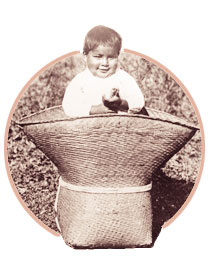 Unit III Unit III
Discovering the Obvious: Our Lives as "The Folk"
By Paddy Bowman, Sylvia
Bienvenu, and Maida Owens
We children played outside under the fig
trees. Emery Bourgeois was the farmer. I was his helper. Libbon . . .
Bourgeois and his brothers, Mac and Willard, had filling stations. Howard
may have been the engineer. I was the only girl farmer. Aunt Beulah
reminded me of the many fights we had. Our whole machinery for the
imaginary rice fields we planted were made from empty cans. Tin cans were
treasured as toys. . . . Then we had to pretend we had wagons, horses,
rice planters, and even a deep well, too. We made many canals and we would
use the long handled water pump in the yard to irrigate our rice
fields.
--Effie Andrepont, Acadia Parish
Unit Introduction
The idea of "the folk" arose as 19th
century European scholars began studying peasant life and looking
for quaint old ways of doing things. For example, the Grimm Brothers
collected many tales, which they later revised and published. Early
folklore scholars collected ballads and tunes as well, searching for
ancient songs. Today folklorists study many forms of traditional
cultural expression, contemporary as well as from the past. They
collect from all classes of people, not just rural residents or
recent immigrants. Unit III introduces students to folklife concepts
and definitions and, most importantly, grounds them in their own
folklife so that they begin to see that everyone has folklife. By
starting with themselves, students will be able to comprehend
further folklife studies more fully. They will start to learn that
many traditions cut across various folk groups, yet each family has
its own unique folklife. If you undertake no other units in this
guide, these lessons are the most important.
Unit III Resources
Unit III Outline
|



